The trade paperback for You are Obsolete hits your local comic book shop on June 16, the book is an insane, intense, thriller, and Monkeys Fighting Robots got to talk with the writer of the series, Mathew Klickstein.
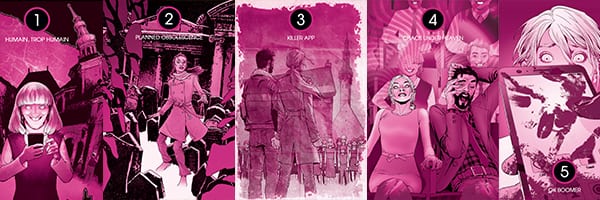
About the book:
YOU ARE OBSOLETE is a spine-tingling thriller that evokes the eerie naturalism of 1970s horror films with a modern deadly digital twist.
A disgraced journalist is called to cover a mysterious story on an isolated European island. As she investigates, she discovers the children have taken control and are somehow killing off all adults by their 40th birthdays. Now, she must discover the truth behind the killings while staying on the good side of the children’s harsh leader…or she’s next.
You are Obsolete is written by Klickstein, with art by Evgeniy Bornyakov, Lauren Affe drops the color, and you will read Simon Bowland’s letters.

MFR: YOU ARE OBSOLETE is very intense; what techniques did you use to create tension in your comic book?
KLICKSTEIN: Thank you for so saying, and it’s been extremely rewarding to see how readers and reviewers have connected with the story, characters, and particularly the eerie tone/atmosphere of YOU ARE OBSOLETE.
I believe the series has resonated on such an intense level emotionally with so many fans is that I grew up on a steady diet of the best of sci-fi/horror from yesteryear, be it The Twilight Zone, the works of Ray Bradbury, Stephen King, Michael Chrichton, Philip K. Dick, Jules Verne and their ilk. These were my real, lifelong teachers as I developed my own writing style and I really do believe I learned how to develop stories and characters through my voluminous reading and watching of the works of these giants of the genre(s), absorbing in some ways what it was that allowed these creators to conjure up such fantastic and creepy tales.
When I sit down to write, it’s rare I have much idea of where I’m going or what I’m doing; I’m the type of author who allows the characters to dictate where we’re going and what we’re doing. That’s a major part of the rush of writing for me. When it’s really flowing, I feel more like a stenographer than anything else.
But, again, I think a lot of this comes from the fact that I have always – and continue – to immerse myself deeply in the works of the great masters of the past (right now I’ve been revisiting Franz Kafka, HP Lovecraft and Edgar Allan Poe, along with going back to some of Stephen King’s earliest short stories, for example). And I always give that same advice to those who ask me how they can get so inspired to write stories of their own: read a lot, and read the good stuff. It wears off on you, for sure.
MFR: The book also has the reader reaching for the answers to the mystery. How did you know how much information to give the reader to make them turn the page?
KLICKSTEIN: That’s a really great question and something I haven’t thought about before.
I don’t mean to be oblique here, but I suppose it goes back again to what I was saying earlier: I learned how to develop my characters and stories through osmosis of the many books, short stories (not to mention interviews, autobiographies/biographies/documentaries etc.) I’ve ravenously read and watched over the years of the masters of sci-fi/horror. As with that creepy tone/style we were discussing earlier, such a steady diet of sci-fi/horror material also greatly impacted my pacing here, and that in turn affected how the information in the “mystery” elements of the story unraveled.
In the case of YOU ARE OBSOLETE, I felt particularly inspired by a lot of favorite movies of mine from the 60s, 70s, and 80s – The Wicker Man, The Stepford Wives, Videodrome, They Live, Carnival of Souls, Village of the Damned, Repulsion, etc. As eclectic as these films are, they all have in common a kind of subtle, slow-burn rhythm to the way their narratives and their own mystery elements progress.
Agatha Christie has been a major source of inspiration for me ever since I was a kid and used to read her books – such as And Then There Were None – over and over again, the way a musician might listen to the same song or record over and over again both for the visceral enjoyment of it … but also to better understand and “absorb” how the song or record was constructed.
I can’t really say specifically how I developed the pace of information dispersal in YOU ARE OBSOLETE; I don’t really use outlines or charts or whatnot the way more meticulous or analytical authors/creators often do. I can only say I’ve repeatedly read and watched the works that have really touched me in a profoundly creative way over the years, and I suppose indirectly they endowed me with a likeminded tone, style and – yes – rhythmic flow that runs throughout my own works such as YOU ARE OBSOLETE.
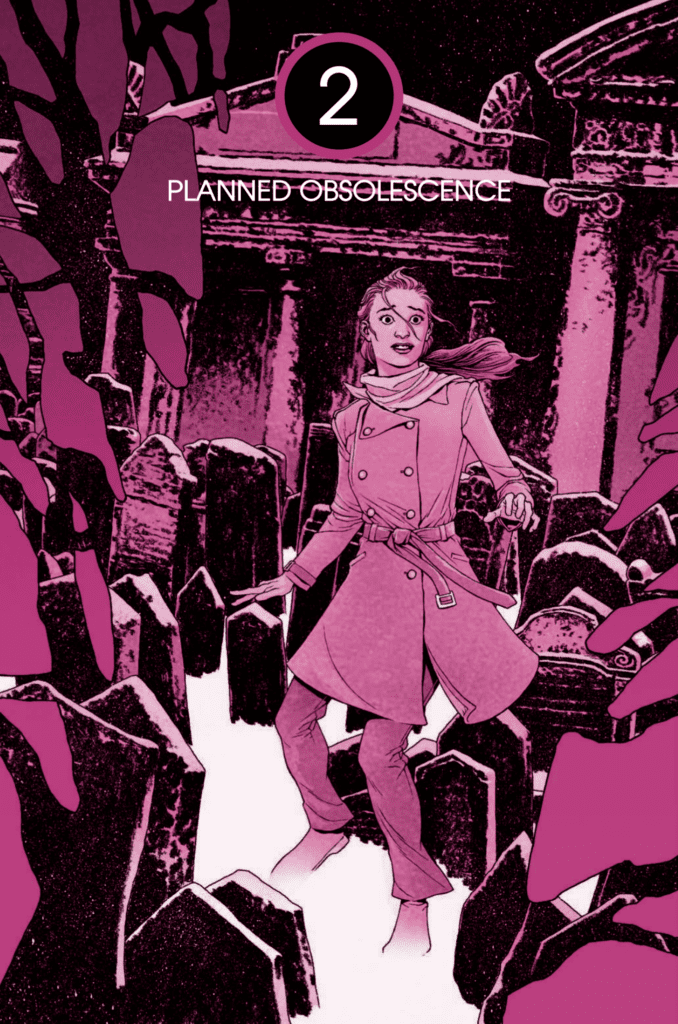
MFR: The artwork in YOU ARE OBSOLETE is brilliant. Talk about what Evgeniy Bornyakov brought to the table as the artist of the series.
KLICKSTEIN: I agree, and it seems that’s a unanimous take on YOU ARE OBSOLETE. The artwork is simply stunning.
Evgeniy did an astonishing job, and I always like to let everyone know that not only is he a genius craftsman, but he’s incredibly fast too. It could be moderately unnerving: I would see some of his work for a few panels and always be immediately blown away. But a few times (very few), there might be a tweak or two needed, and I tell you, more than once it was only minutes later that I would receive back the redesigned images, and they would be exactly what I called for. I couldn’t believe it.
He’s like a machine, and yet there’s so more humanity and vivacity to the work that what he produces doesn’t just look like some kind of plastic CGI output. His images are so alive and real, and the fact they’re so spectacularly mesmeric at the same time made me feel so lucky that AfterShock brought him onboard YOU ARE OBSOLETE.
MFR: How did your relationship evolve over the five issues with Evgeniy?
KLICKSTEIN: Truth be told, I never once spoke directly with Evgeniy. I’m not even sure exactly where he lives – I believe somewhere in Russia? All communication with him was mediated by my editors at AfterShock, Christina Harrington and Mike Marts – who both also did a phenomenal job of working with me throughout the course of completion, especially since I was a first-timer here.
I wrote the scripts as detailed and specifically as possible so that the artists would understand exactly what it was I wanted – exactly how the characters should look, how the lettering should be done, how the coloring and compositions of the panels should be realized. Christina and Mike would then relay this information to the artists, I would go over their sketches and rough work, explain if there were any tweaks needed (infrequent), and Christina and Mike would then relay those details back to said artists, they’d make the changes, and – BOOM – the pages/issues/series were steadily completed.
There was some degree of evolution, though, in the process in that I could reference certain previous images, panels, facial expressions, and so forth that helped move things along more swiftly later on. A prime example here is that I had some difficulty communicating to Evgeniy exactly how I wanted those horrific smiles of the adult characters in the story to look. In Evgeniy’s earliest sketches, they appeared too malevolent, as though the characters were up to something evil themselves. After revisions, they just looked sad and pathetic, which was also not quite right.
I found using screenshots – in this case one from the film I, Tanya where the Tanya Harding character played by Margot Robbie is smiling so painfully, so intensely at one point after successfully completing one of her major skating routines and a few from the “It’s a Good Life” episode of The Twilight Zone – helped to convey what I was looking for in those facial expressions of our adult characters.
Once Evgeniy nailed the complex nuance of those facial expressions, during the production of later issues I could say, “Can you make the expressions look like how you made them look in Issue 1 and 2?” That shorthand really helped us move faster still later on, which was great.
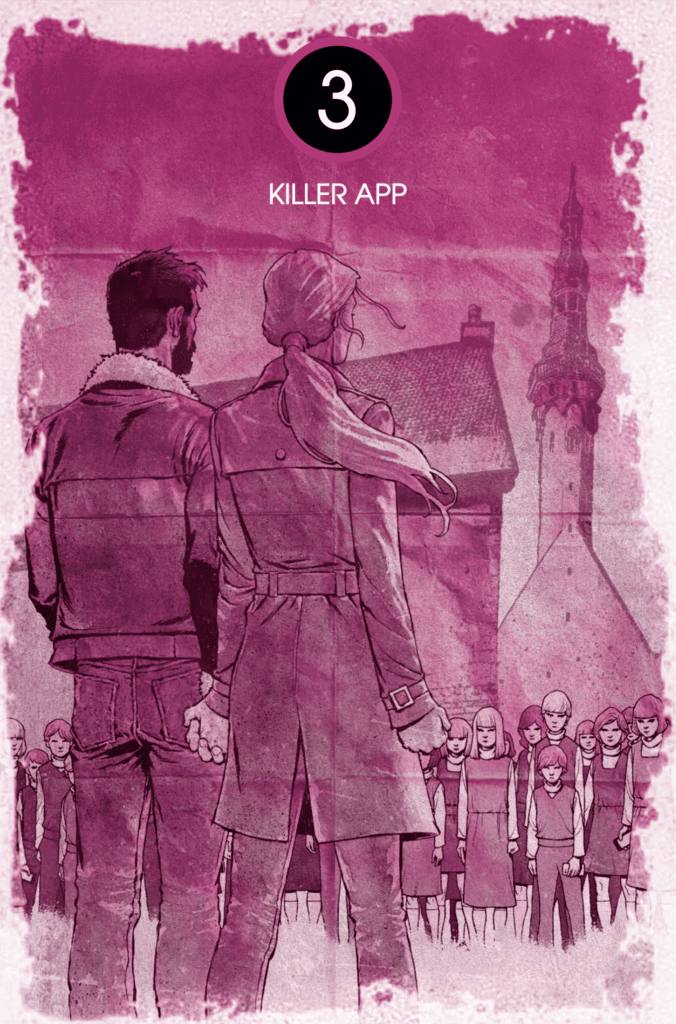
MFR: Do you have a favorite panel or page from the book? If so, please explain why.
KLICKSTEIN: Although as mentioned I didn’t have an outline or too much of a specific idea of where the story and characters would take me along the way of my completing YOU ARE OBSOLETE, I did have a basic understanding of the beginning/middle/end on a general level and was eagerly awaiting Issue 4 (“Chaos Under Heaven”), which indeed became my favorite installment of the series.
Honestly, I still can’t believe my editors Christina Harrington and Mike Marts allowed me to create that issue the way I did. I was truly worried when I turned in that script and assumed that I would hear back from them that I needed to do a full rewrite. It’s just so weird and different than conventional comic books. Both in content and in style.
Much to my amazement and relief Christina and Mike seemed to really dig what I was doing with that one, and Christina in fact was particularly jazzed, coming up with ways we could push the form and style even more with ideas I hadn’t considered regarding how the lettering could be done for that issue and so forth.
I had to work closely (again, through mediation via Christina and Mike) with Evgeniy as well as colorist Lauren Affe on how we were going to alter the aesthetics of Issue 4 because I wanted it to really stand out and be something special even within the context of the series itself.
SPOILER ALERT: The whole issue is basically one long-running, “real-time” mushroom trip the main character goes on, and in so doing, she has flashbacks to her younger years in which we learn a great deal more about who she is, where she came from and why she is the rather complicated person we’ve gotten to know her as through the first three issues. I had a lot of fun delving deeply into her psyche here and, certainly, with the spectacular work of Evgeniy and Lauren in particular, we were able to take the reader on this psychological adventure while still offering some spellbinding imagery that would really pop throughout the pages.
Meanwhile, in plunging the reader into main character Lyla Wilton’s backstory, I was able to offer up some important ideas about how her industry (and, for most of my life, mine too), Media, has changed for good or ill over the past decade or so. I didn’t want to be too pontifical here, but it was in these panels that I was allowed – both by Christina and Mike, but also the organic flow of the story itself – to connect what Lyla was going through to the genuine, contemporary reality of Media today, which is a subject near and dear to my heart as both a consumer and creator in that field.
Many of my journalist friends – including John Wenzel of the Denver Post who offered the blurb that we used on the cover of the trade edition about the story being a perfect summation of what’s happening in the modern world – were equally delighted to see that I could make a few points about certain unfortunate realities to our changing industry. That was a very satisfying result, as well.
I’m grateful that with Issue 4 we were able to create something that was artistically very pleasing, that really took up the thrills and horror elements up a notch due to Lyla’s intense mushroom trip, but that I was also able to find an organic and meaningful way to make a few points about some real issues affecting us all today.
MFR: Another aspect that works well is Lauren Affe’s colors. Did you have a color palette in mind when designing the book?
KLICKSTEIN: For the most part, I gave Lauren a significant amount of carte blanche in her color palette and how she brought the brilliant effulgence to each panel throughout the series.
There were of course, instances in which certain coloring flourishes were needed – I wanted the earlier elements of the story to evoke an old-timey nostalgic feel and hence the de-saturated, sepia-toned of those panels, for example. Again, we had to work more closely for Issue 4 due to the way we were changing up the aesthetic overall of those pages, as well.
But for the most part, I have to hand it to Lauren – she really handled the coloring herself and I couldn’t be more proud of how it turned out. She completely “got” what I wanted to do from the story and characters alone, and – as with Evgeniy – I didn’t have to say much to get her to do what was needed to make the series what it became.
One part I did have some fun with her was when we were trying to figure out how the screens of the children’s phones would look when they engaged the killer app, which is the central plot point of the narrative. Once again, I found that screenshots from films would help best here and, in fact sent her shots of the amorphously radiant “shimmer” border from Alex Garland’s Annihilation, which Lauren immediately understood and incorporated into the coloring for those scenes in a way that was just right.
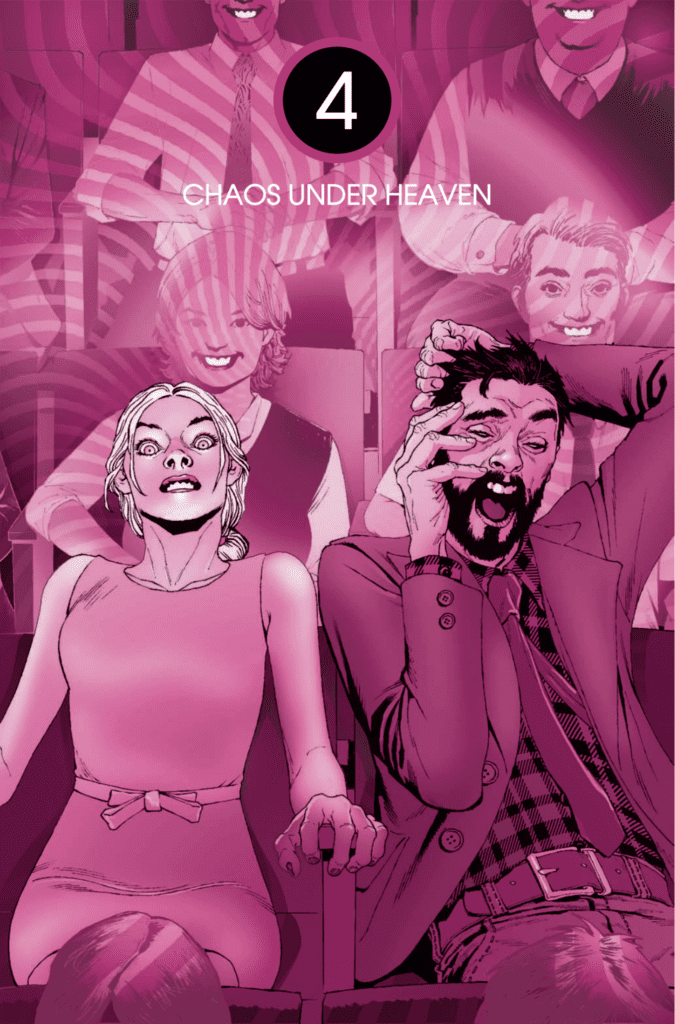
MFR: Social commentary is a big part of YOU ARE OBSOLETE. Over your career, how has the good and bad of the current state of the world influenced your writing?
KLICKSTEIN: Having been a journalist for more than half my life, I can’t help but inject at least some form of social commentary – whether directly or indirectly – into all of my work.
It’s just a part of who I am, and I became politically active at a young age – working on political campaigns and for various organizations such as the ACLU as early as high school and well through college. For a while in my late teens, I thought I might become a speechwriter.
Even as a kid in elementary school, I used to be a bit of a “troublemaker” in arguing with teachers or just generally being a pain in standing up for what I believed in.
I think I organized my first petition signing campaign in fourth grade and led a protest involving a group of students about some minor issue even before that. I think we were mad; they were cutting recess a little short and refused to leave the basketball court. I got the other kids to chant, “Hell no, we won’t go!” I was maybe seven or eight during that escapade.
I was remarkably fearless for a little kid, very irreverent and – with a former hippie mom who raised me to always “tell it like it is” even to older authority figure types, I ended up being a little firebrand by habit at a very young age. I’d be lying if I didn’t say it wasn’t exhilarating and “fun” too. But, yeah, I was also a little asshole in some ways, and after a while, the “lil’ rabble-rouser” routine got old.
Some of this background of course impacted how I developed Lyla’s character, particularly those scenes in Issue 4 in which drug-addled flashbacks chronicle how she became the inveterate truth-seeker and truth-teller she fancied herself as.
As I grew older, I calmed down a fair amount and – through enough experience in the field – grew completely disillusioned by politics. But I still had and have that kind of contrarian style to a lot of my work, even in my more mainstream, commercial output. It’s part of my DNA as an artist and a person in general, I suppose.
And, yes, in observing how our society has been precipitously evolving over the past few years – especially in reaction to developments in fields I’m involved in or have close friends involved in from the inside such as Media and “new-tech” – I couldn’t help but let some of that insider analysis come through in telling Lyla’s story, especially since the entire series is one long confession of hers told after the fact as a kind of “report” on what happened, which does include the social, psychological and cultural ramifications of said story, often including those that are affecting all of us in a very real way today.
To me, that’s a big part of why so many of the great sci-fi stories we love, be they The Twilight Zone or They Live or Fahrenheit-451 or Brave New World and 1984 continue to resonate with us decades after they came out. They’re not only fantastic stories with well-crafted characters we grow to love and hate on an indelible level. They also say something about the time in which they were created and, if they’re really special, about the general human condition that can deeply connect with us still so many years later.
I dearly hope I have some of that magic in YOU ARE OBSOLETE, but only time will tell. And if nothing else, at least it’s hopefully an adequate time capsule of the continuously shifting era we’re living in today or that we were living in during the months the series was developed and completed.
MFR: Lyla Wilton is an engaging main character. How hard is it to create a main character that readers connect with?
KLICKSTEIN: To have attempted such a complex character that seems to have stuck the landing quite well according to how readers and reviewers alike have been connecting with her is of course very gratifying. She’s not a hero. Heroes can be pretty boring, off-putting and unrealistic. That wouldn’t have worked for this story.
I needed someone real to recount the story, and it seems that’s what I conjured up with Lyla Wilton. That in turn, helped make the story feel more palpable – even in its more fantastical, sci-fi elements – which in turn makes it that much more intensely frightening.
It wasn’t very hard at all. As I said, she just kind of popped into my head and told the story herself. All I had to do was listen closely and write down what she laid out for me. Some might call this a form of insanity, but as Hunter Thompson once said (probably far more than once), being crazy can pay.
MFR: What did you learn from the process of making YOU ARE OBSOLETE that’s going to make you a better storyteller?
KLICKSTEIN: I’m a firm believer in the Dodo’s dubious wisdom from Alice’s Adventures in Wonderland that the best way to explain something is to do it. I find this to be absolutely true when it comes to developing yourself as a storyteller or artist. Whenever someone asks me how he or she can become a writer, I always say, “Just start writing.” (And, of course, read a lot, and watch a lot of good movies.)
Learn from doing, learn from observing. I’ve never gotten much from direct education viz. writing or creativity, and this was after four years at the top film school in the country. Mark Twain said it best: “Never let your schooling interfere with your education.”
I’ve always learned so much more and so much faster from just sitting in that chair and getting it done. Which is one of the reasons why I feel so fortunate I’ve been able to continue my “education,” if you will, over the years through writing and producing in all these different mediums and via various platforms be they film, television, reportage, theater, and yes now comic book creation.
I had absolutely no idea how to put together a comic book before I pitched the story of YOU ARE OBSOLETE to AfterShock. Mike Marts in fact had to send me a few sample scripts from books AfterShock had released just so I could teach myself the language, structure, and ebb-and-flow of a publishable comic book.
I wasn’t thrown into a pool, having to learn how to swim. I was thrown off a cliff, having to learn how to fly. There was no time (or money/resources) to take a class or go to a seminar or something. I learned by doing.
And, from what it seems from the stellar reviews of this debut series of mine, I guess I learned quite a lot.
Collaborating directly with my editors and indirectly with the artists onboard also reinforced and taught me new tricks for working with others on creative projects, and it reminded me too how much I enjoy such esprit de corps, particularly when you’re lucky enough to work with such capable, passionate and hardworking individuals on your project.
In essence, what did I learn from the process of working on my first comic book series? I learned how to work on my next comic book series. And hopefully many more thereafter.
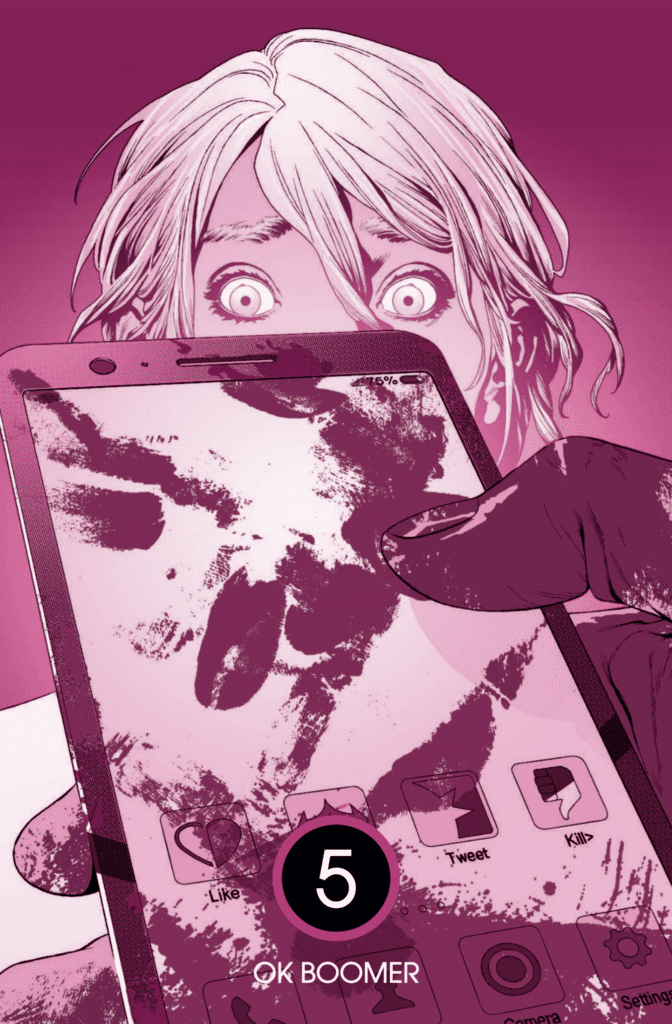
MFR: With the COVID-19, the comic book industry is at an evolutionary moment. What do you think the comic book industry will look like in 10 years?
KLICKSTEIN: I certainly can’t make such a prediction, and I don’t think anyone else can either. Whatever’s going to happen is going to happen, and we have no control over the waves here, only how we choose to surf them.
But I will say that the human race has proven again and again over the centuries to be a resilient bunch. We’ve survived much worse than this. Along with we as individuals, our culture and society has survived throughout some of the worst traumas – natural or manmade – imaginable and unimaginable.
A lot of this comes down to perspective, how far back and how deep into the past you wish to reach to discover where we’ve gone and where we’ve been in the past. And one thing you discover if you go back far enough, if you go down deep enough, is, yes, we survive. We survive and even often flourish during plagues, during world wars, during famines, and all manner of natural disasters. Society and culture persist. Always.
I believe this is true throughout the history of the evolution of the arts and entertainment as well. There were those who thought the printed page would destroy storytelling as we knew it, which before then was oral only. Nope. There were those who thought radio would destroy the printed page. Nope. Those who thought television would destroy the movie industry. Nope.
Yes, the progression and proliferation of the Internet – particularly its problematic and plutocratic economic infrastructure – has had some devastating effects over the traditional Media and entertainment industries. But, there are still newspapers. There are still cable channels. There are still movie theaters and even drive-in movie theaters.
There are still record stores, and there are still and will still remain comic book shops, comic book conventions and printed comic books that people will want to hold in their hands, buy on New Comic Book Day every Wednesday, trade/exchange with one another, criticize, analyze, scrutinize and adapt to film/television.
One thing I’ve learned throughout the process of creating YOU ARE OBSOLETE and going out to conventions and stores for signings events etc. is that the comic book industry is indeed its own subculture and community.
The consequences of the COVID virus and the quarantine/containment period are dire and vast, for sure. But, the comic book community is robust, supportive of itself and its members, and ultimately encouraging.
People are bursting at the seams to go back outside and to stores. They want to talk with others in person and shake hands, hug, smile, laugh, argue, point fingers in faces, knock over tables, paint murals on store walls, go to museums, admire great works of art in person and share real-life, here-and-now experiences away from the mediation of the cold, inorganic glass teat of screens.
Human beings – especially “creatives” – are social creatures. And we’re creators. We want to be with each other, and we want to make things we can hold and feel and give to one another and trade with one another. That innate truth is not changing. It never has and never will.
There is a pernicious segment of our society’s upper-crust that both directly and indirectly profits off of keeping us scared and disputatious, hiding away from one another, consigned to our cave-like rooms and interacting only digitally with one another and the “outside world” writ large. But the overwhelming majority of us will never allow that horrific reality to persist.
And so to the comic book industry and its commensurate community still have a long way to go before they’re ever – if ever – obsolete.
What AfterShock Comics are you reading? Comment below with your thoughts.

